| Posted: Jul 01, 2011 | |
Patent analysis and product survey on use of nanomaterials in lithium-ion batteries |
|
| (Nanowerk Spotlight) The efforts undertaken in developing renewable energy sources to reduce our dependence on fossil fuels include major research and investment in advanced electricity storage technologies. Among the various existing technologies, lithium (Li) batteries are considered as the most competitive power source because of their high energy density, superior power capability, design flexibility and longer lifespan. | |
| Use of lithium in batteries was first reported by A. V. Fraioly et al.1) in 1968, and the first rechargeable Li battery was proposed by M.S Whittingham2-3). Further, the concept of secondary Li battery was first demonstrated by D.W Murphy et al. 4) in 1978. Ground-breaking cathode materials (lithium cobalt oxide) research was carried out by a team led by John B. Goodenough5-6) following which Sony brought out the first commercial lithium ion battery in 1991. The first use of any nanomaterial was reported by Hyperion Catalysis International Inc. wherein they have used carbon fibril as anode material of lithium battery7. | |
| Li-ion batteries have become the dominant power source for portable electronic devices – like cell phones, laptops, digital cameras etc. – due to their superior energy density and high cell voltage. They are also the technology of choice for the large emerging markets of hybrid, plug- in hybrid and electric vehicles and aerospace applications. | |
| To meet the future challenges of energy storage, a new generation of Li-ion batteries with excellent performance, long cycle life, safety and reliability are needed not only for applications in consumer electronics, but especially for clean energy storage and use in all electric vehicles and for aerospace applications. | |
| An emerging understanding of nanoscience and the developments in the field of nanotechnology have offered solutions to energy storage applications. Advances in electrochemistry, surface science, and materials science have stimulated the use of nanomaterials in more efficient energy storage and battery systems. Nanomaterials have the potential to significantly enhance the performance of lithium-ion batteries. The prominent impact in terms of high power is envisaged due to their reduced dimensions that enable to achieve far higher surface/interface Li storage and intercalation/deintercalation rates. | |
| The present study has been conducted to get an overview of the current patent landscape of rechargeable Li-ion battery, with a focus on the recent developments on nanomaterials and nanotechnologies used for anode, cathode, and electrolyte materials, and the impact of nanomaterials on the performance of rechargeable lithium batteries. Effort has also been taken to identify key players, emerging trends and applications in this area. | |
| Figure 1 depicts the patenting trend in the field of nanomaterials-based Li-rechargeable batteries, as obtained from the analysis of relevant patents. The research activity in this area was initiated in 2000, and since then, there has been a continuous growth in the patenting trend. However, an exponential rise in the R&D efforts can be seen from 2009 onwards due to the commercial success in using nanomaterials for Li-ion batteries. | |
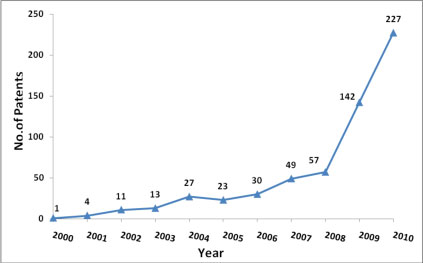 |
|
| Fig. 1: Annual growth of patents related to nanomaterial-based Li-ion rechargeable batteries (Source: www.thomsoninnovation.com) | |
| The patent applications have been classified based on the focus of inventions as presented in Fig. 2 below. It is apparent from the figure that 60% of the patent applications have been filed exclusively for nanomaterials used in Li-ion batteries. Further, 26% of the patents, in their claims, have included research on materials as well as fabrication of Li-ion batteries. | |
| Even though the first direct use of nanomaterials in the fabrication of Li-ion battery has been reported in 19937, analysis shows, this trend has been increased significantly in the last few years due to a significant amount of research that is being carried out in the area of nanomaterials as well as due to the increase in the demand for high performance Li-ion batteries. Matsushita Electric Ind. Co., Ltd. has been focusing their research activity, mainly in the fabrication of Li-ion batteries that incorporate nanomaterials whereas BASF, BYD Co., Ltd. and Hon Hai Precision Ind. Co, Ltd have focused their R&D activity in developing nanomaterials. | |
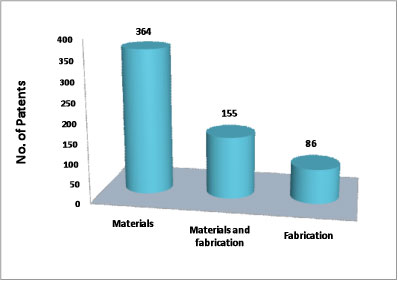 |
|
| Fig. 2: Segmentation of patents based on focus of the claimed invention. | |
| An analysis of patents reveals that the majority of developments in advanced rechargeable batteries are directed towards wider applications in three distinctive categories: | |
|
|
|
| Further analysis shows that patents have also been claimed for the use of Li-ion batteries in various biomedical applications such as neurological stimulation device, cardiac defibrillator, cardiac pacemaker, cardiac contractility module, cardiac contractility modulator, cardioverter, drug administration device, cochlear implant, hearing aid, diagnostic recorder, sensors and in telemetry device as well as spacecraft applications. | |
| Various nanomaterials are being used in different components of Li-ion battery such as anode, cathode, electrolyte, and separator. Nanomaterials, providing higher reactivity and short diffusion length for Li ions, enable researchers to modify existing electrodes. | |
| Figure 3 gives the categorization of patents focused on various components of Li-ion battery for which nanomaterials are being developed. It becomes very clear from the figure that research activity on nanomaterials is concentrated for anode development followed by cathode. Nanotechnology has been implemented in electrolyte and separator components as well. Even though the research activity has been intense in the field of anode materials which is centered on various carbon-based materials and lithium alloys, diverse nanomaterials are being explored for cathode applications. | |
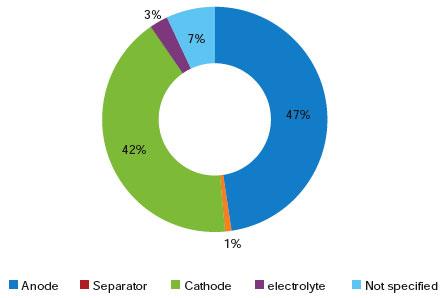 |
|
| Fig. 3: Categorization of patents based on different components of Li-ion battery for which nanomaterials are being developed. | |
| Analysis reveals that nanocrystalline intermetallic alloys, nanosized composite materials (e.g. Polymer composites), carbon nanotubes/nanofibers and nanosized transition-metal oxides are all promising new anode materials, whereas nanosized LiCoO2, LiFePO4, LiMn2O4, carbon nanotubes and nanofibers show higher capacity and better cycle life as cathode materials for Li-ion batteries. | |
| Nanosized metal-oxide powders, metal nanoparticles and CNTs were also added to polymer electrolytes to improve the performance of the electrolyte for all solid-state lithium rechargeable batteries. Similarly, nanotechnologies have been used for separators (e.g. nanostructured polyamide). Different synthetic routes have been discussed in the patents for the fabrication of nanostructured materials that can alloy with Li, which includes ball milling, sol-gel, electrospinning and electrodeposition. Chemical vapor deposition, electrostatic spray deposition, ultrasonication, polyol method, functional coatings, heat treatment, plasma processing and gamma-ray irradiation etc. are also being used for the synthesis or processing of nanomaterials for their use in different components of Li-ion battery. | |
| Figure 4 highlights the top 10 assignees of patents published/granted in the area of nanomaterials-based Li-ion battery. The analysis reveals that South Korea-based Samsung SDI Co, Ltd is the leader with 24 patent applications to their credit followed by BASF, Germany and Hon Hai Precision Industry Co, Ltd., Taiwan, with 14 patent applications each during the analysis period. Samsung SDI Co, Ltd. has been involved in the development of carbon nanotube/nanofibers and silicon nanoparticle based anode materials for Li-ion battery which will be used in consumer electronics applications. Similarly, BASF has involved in material based research where the lithium iron phosphate and CNT/carbon nanofibers are being developed as cathode materials for batteries. Analysis reveals that Mitsubishi Materials Corp, LG Chem, Ltd. and Dr. Jang (CEO of Nanotek Instruments, Inc.), have also done significant amount of research in the area of electrodes. | |
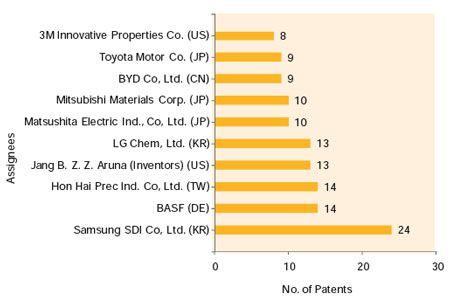 |
|
| Fig. 4: Top 10 assignees for nanomaterials based Li-ion battery. | |
| Figure 5 (a) and (b) indicate the country-wise and region-wise distribution of patents in the area of nanomaterials-based Li-ion batteries. The maximum number of patent applications (149) related to the subject were filed by assignees from Japan followed by United States (133), China (132), and South Korea (120). Further analysis shows that Taiwan has also done remarkable amount of research with 27 patents to their credit. In terms of regions, Asia-Pacific (72%) is the front-runner in the nanotechnology-based Li-ion battery patent filing followed by North America (23%) and Europe (4%). | |
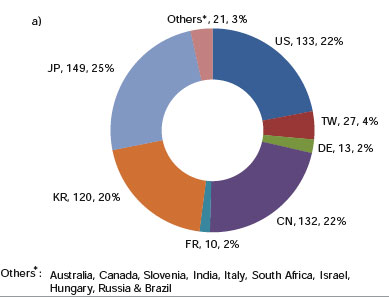 |
|
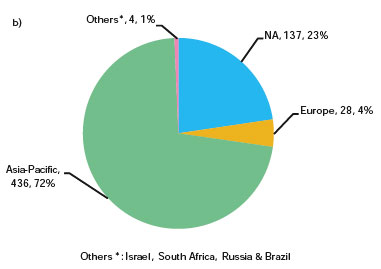 |
|
| Fig. 5: Segmentation of patenting activity on nanomaterial-based Li-ion battery based on (a) countries and (b) geographic region. | |
| Global Market Scenario | |
| The global market for secondary lithium-ion batteries was $8.4 billion in 20108). Asia accounts for approximately 48% of global market share followed by North America (26.3%) and Europe (22.9%). Further, consumer applications account for about 71.4% ($6.0 billion), while industrial applications account for about 28.6% ($2.4 billion) of total revenues. | |
| The global market for nano-enabled batteries is expected to reach $1.13 billion by 2013 from $169 million in 2008 with an average annual growth rate (AAGR) of 46.3%9). By 2013, electric vehicles (EVs), hybrid electric vehicles (HEVs), plug-in hybrid electric vehicles (PHEVs) and specialty electric vehicles will have 84.7% share of the global market, which shows AAGR of 71.8% from 20089. According to the Electronics.ca report, the global market for nanomaterial-enabled lithium ion battery systems was $63 million in 2010, and expected to grow at a compound annual growth rate (CAGR) of 37 %, rising to $575million by 201710). The major driver for the market growth is the increasing acceptance of nano-enabled Li-ion battery. However, Li-ion battery industry is also facing various challenges regarding cost and safety. | |
| Some of the key drivers include the following: | |
| Key Drivers | |
|
|
|
| Market Drivers | |
|
|
|
| Some of the key challenges to develop high performance Li-ion batteries include the following: | |
| Challenges | |
|
|
|
| Nanotechnology-enabled Li-ion battery Products available in the Market | |
| To get a clearer picture of commercialization of nanotechnology-enabled Li-ion batteries, a survey has been done for various players present in the market. | |
|
|
|
| Raw materials suppliers for nanotechnology-based lithium-ion batteries | |
|
|
|
| Conclusions | |
| The present analysis on nanotechnology-enabled Li-ion batteries demonstrates that nanomaterials and nanotechnologies are promising for the new generation of Li-ion secondary batteries. Several nanomaterials have been identified, which have great potential to enhance the performance of Li-ion battery. Innovative approaches to materials science and battery engineering are available from a large number of very significant companies like GE, Panasonic Corp, SANYO Electric Co., Ltd., Matsushita Industrial Co., Ltd., NEC Corp, SAFT America, Inc, Toshiba Corp, BYD/Berkshire Hathaway, LG Chem, Ltd., Altair Nanotechnologies, Samsung SDI Co, Ltd, Sony Corp, A123 Systems, Inc. and Altair Nanotechnologies. Diverse applications of Li-ion batteries for clean energy storage applications assure that all major stakeholders such as consumer electronics manufactures, electric and hybrid vehicle manufactures and other high end users are keenly interested in developing new manufacturing techniques, which will bring down the cost of production for widespread deployment. | |
| References | |
| 1. A.V Fraioly, W.A Barber, A.M Feldman, "Composite Paper Electrode for a Voltaic Cell", US Patent No. 3,551,205, Dec 29, 1970 (Filed on December 5, 1968), Assignee: American Cyanamid Corp | |
| 2. M.S. Whittingham, "Electrical Energy Storage and Intercalation Chemistry", Science (1976) 1126-1127 | |
| 3. M. S. Whittingham, "Chalcogenide battery" US Patent No. 4,009,052, February 22, 1977 (Filed on April 5, 1976), Assignee: Exxon Research and Engineering Company | |
| 4. D.W. Murphy, F.J. Di Salvoa, J.N. Caridesa, J.V. Waszczak "Topochemical reactions of rutile related structures with lithium", Materials Research Bulletin, 13 (1978)1395?1402 | |
| 5. K. Mizushimaa, P.C. Jonesb, P.J. Wisemanb, J.B. Goodenough, "LixCoO2 (0<x 1): a new cathode material for batteries of high energy density", Materials Research Bulletin, 15 (1980) 783?789 | |
| 6. M. M. Thackeray, W. I. F. David, P. G. Bruce, J. B. Goodenough "Lithium insertion into manganese spinels", Materials Research Bulletin, 18 (1983) 461?472 | |
| 7. I.Hiroharu, H.Robert, R. Hausslein, "Lithium battery with electrodes containing carbon fibrils", US Patent No. 5,879,836, March 9, 1999 (Filed on September 10, 1993) | |
| 8. "World Lithium-ion Battery Market", June 2010, published by Frost & Sullivan http://www.frost.com/prod/servlet/report-toc.pag?repid=N76F-27-00-00-00 | |
| 9. "Nano-enabled Batteries for Portable and Rechargeable Applications: Types, Applications, New Developments, Industry Structure and Global Markets", Feb 2009, published by iRAP, http://www.innoresearch.net/Press_Release.aspx?id=15 | |
| 10. "Nanomaterials and the World Lithium Ion Battery Market", February 2011, published by Electronics.ca http://www.electronics.ca/publications/products/Nanomaterials-and-the-World-Lithium-Ion-Battery-Market.html | |
| By Prajakta S. Kuyate and Vivek Patel, Centre for Knowledge Management of Nanoscience and Technology (CKMNT). | |
|
Become a Spotlight guest author! Join our large and growing group of guest contributors. Have you just published a scientific paper or have other exciting developments to share with the nanotechnology community? Here is how to publish on nanowerk.com. |
|
